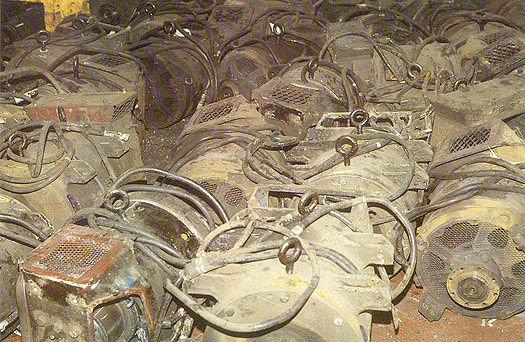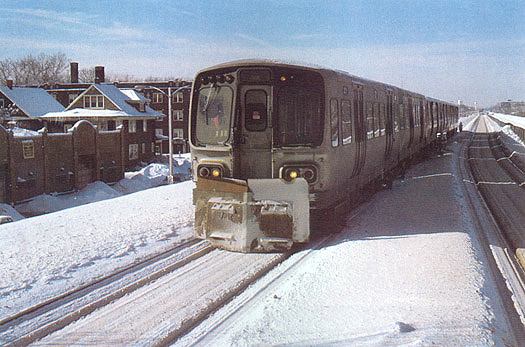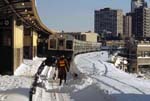

![]()
According to the U.S. Department of Commerce Weather Bureau, Chicago's average annual snowfall is 33" and rarely exceeds 40". Since records began to be kept in 1899, there have only been four winters in which total snowfall exceeded 60". But during the winter of 1978-79, the total was a staggering 88.4"! And by the end of January, there was an accumulation of more than 47" on the ground, most of which was compacted ice!
 Car 24, with its distinctive paint scheme and bright orange belt rail, acts as a snowfighter against continuing snow drifts. The unit, operated by Superintendent Bruce Anderson, is approaching Davis station on the Evanston Line on January 16, 1979. For a larger view, click here. (Photo from the Chicago Transit Authority Collection, reprinted from CTA at 45) |
Transportation came to a standstill for several days. The CTA had snowfighting equipment, mostly cars fitted with small snowplows suitable for the 8"-12" of snow that usually falls at any one time. But it soon became apparent that these were inadequate against the 27" of snow on the ground and so the shops manufactured makeshift plows of heavy plywood laid in cross-grained layers of up to 6". The use of wood instead of steel kept the plows insulated against the 600 volt DC third rail. The plows were attached to the front of married-pair units, using both designated work cars and revenue units from the passenger fleet.
To try and keep the lines open, cars were kept out
on the lines, attempting to push their way through the snow.
This proved to be a major miscalculation, as much of the snow was
actually being plowed by the motor and undercarriage, not the car
body. Snow was forced into cars part and electrical equipment,
causing damage to brakes, motors, generators, and couplers. Deicing
salt used by IDOT on the expressways caused electrical motor failures
on trains running in highway medians. The salt (a well-known enemy of
electrical insulation) shorted out third rail circuits and caused
equipment fires. The Dan Ryan Line was particularly hard hit, with
the car casualty list growing longer every day. Cars were borrowed
from other lines to maintain service - including the then-brand new
2400s
- but Between the snow itself and
the extra burden put on them by the Blizzard of 1979, nearly
100% of the cars' traction motors failed within the next
year. Outside contractors were needed to keep the CTA
supplied with functioning motors. A sea of blown motors sits
here at Skokie Shops on February 13, 1979. For a larger
view, click here.
(Photo from the Geroge Krambles Archive, reprinted from
CTA at 45)
they too were disabled. By January 29th, more than half the 890 cars
needed to maintain normal rush hour service were disabled and
unusable.

With capacity down and ridership up from foul-weather fans who found the roads impassable, overcrowding was severe. Trains were delayed by passengers forcing their way into crush-capacity cars, causing longer-than-normal station dwell times. People rode outside between cars or on the ends of trains in the subzero weather. People even jumped on and off moving express trains to get to their stop! On the Dan Ryan Line, trains were at full capacity from the start at 95th Street and stopping the trains at intermediate stations only worsened the delay and compounded the problem. A trip downtown that normally only took 10 minutes was now taking 30 to 40 minutes.
Several alternatives for how to deal with this problem were discussed. One option was to simply suspend all service until snow removal could be completed. The sections that operated on elevated trestles - the Loop, the Englewood-Jackson Park, most of the Ravenswood, the Howard south of Wilson, the Douglas east of Pulaski - had few problems since snow could fall through the tracks and structure to the ground below, but those that ran on the ground or on solid-fill embankments - the Howard north of Wilson, the Evanston, the Skokie Swift, the outer portions of the Ravenswood, Douglas, O'Hare, and Lake Lines, the Dan Ryan and Congress Lines - fought an ongoing battle with the elements. Shutting down would have resulted in a loss of revenues and ridership, but would have saved a lot of hard work and equipment damage. But the alternative selected was to run limited express service during rush hour to save time, speed up service, and serve the most passengers possible with the limited equipment available. The Lake-Dan Ryan was chosen for this since it had the most number of alternative paralleling transit and bus lines within walking distance.
Temporary express service on the West-South (Lake-Dan Ryan) Route was as follows:
The measure proved effective in restoring control and making service productive again, though some commuters were undeniably shafted. In only four days, the system had been restored enough to reestablish local service.
 Temporary snow plows were attached to many cars, including this 2000-series unit near Austin station on the Lake Street Line. The train is helping to fight snow accumulation, which was particularly problematic on the ground-level and solid-fill elevated lines, on January 25, 1979. The powdery snow was often stirred up by the trains and sucked into the self-ventilating motors of the 2000- and 2200-series cars, freezing air intakes and choking off ventilation. For a larger view, click here. (Photo from the Geroge Krambles Archive, reprinted from CTA at 45) |
The poor weather continued for months. During January, the temperature went above freezing on only three days and then only for a few hours. On the 14th and 15th, a record-setting temperature of -19 degrees F occurred. February was bitter cold and had no temperatures above freezing until the 20th. Thawing weather didn't arrive until March 18th! Service was paralyzed when the snow first hit. On January 13th, snow depth up to the motors stopped service on the Skokie Swift, Evanston and outer Ravenswood, Congress, Douglas, Lake, and North-South Routes. Not until the 18th was enough snow cleared to store at least some service on all lines. But periodic snow falls continued to stop service on many lines for intermittent periods of time. The Skokie Swift was the hardest hit, with all service suspended from January 13th to the 18th, then again for three days from the 24th to the 27th.
The disruption of the transit system (and many other city services) caused much criticism and finger-pointing. Much of the controversy surrounded the suspension of service to inner-city stations. Popular wisdom attributes the February 27 electoral defeat of Mayor Bilandic to the difficulties the city had in dealing with the storm.
 |
loyola19.jpg (213k) CTA personnel are working hard to dig out Track 2, the southbound North-South Route track, at Loyola on January 14, 1979, during the famous Blizzard of '79. Over 20 inches of snow fell over the previous few days, and any part of the "L" not on an open trestle-type elevated structure was inundated with enough snow that normal service was impossible. Even minimal service was difficult to maintain with continuing snowfalls and prolonged sub-freezing temperatures. The CTA's snowfighting equipment proved inadequate, leading to trains pushing snow out of the way (causing equipment damage) before temporary snow plow blades could be affixed, supplemented with hand-removal of snow. Note the track marker on Track 1 in the distance nearly buried under the snow. (CTA photo, courtesy of the Krambles-Peterson Archive) |
|
Sources:
Krambles, George and Arthur Peterson, CTA at 45, Oak Park, IL: George Krambles Scholarship Fund, 1993.
MRC Clipping Files:
United States. Weather Bureau. Local Climatological Data. (monthly)